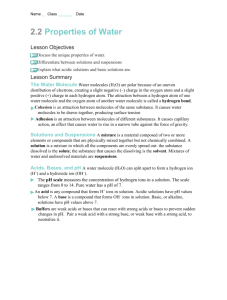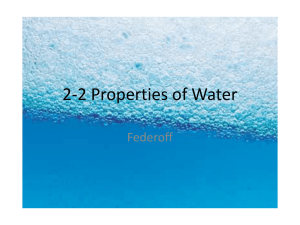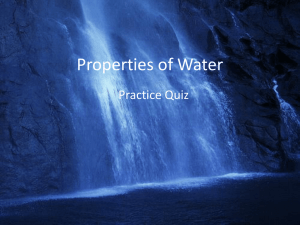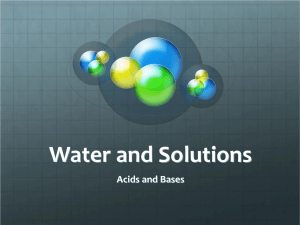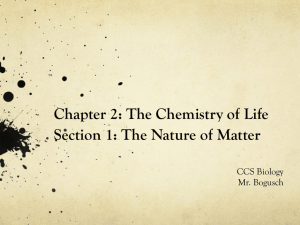2.2_Properties_of_Water
advertisement
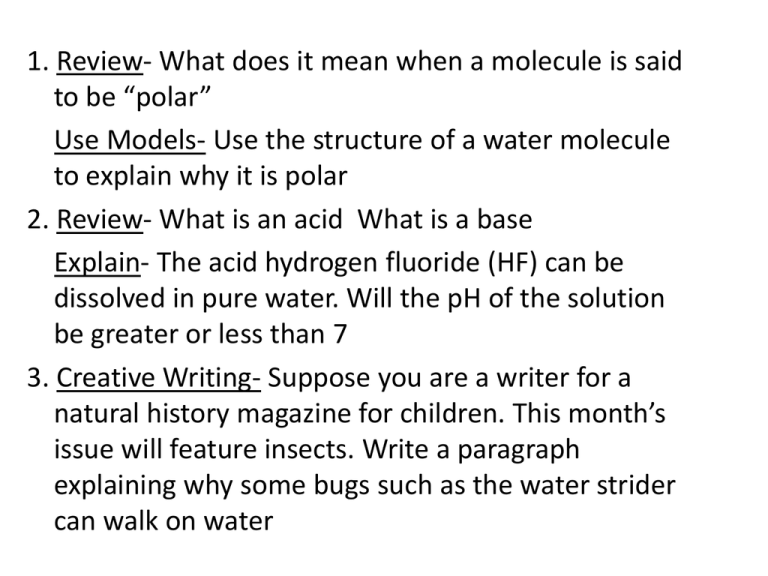
1. Review- What does it mean when a molecule is said to be “polar” Use Models- Use the structure of a water molecule to explain why it is polar 2. Review- What is an acid What is a base Explain- The acid hydrogen fluoride (HF) can be dissolved in pure water. Will the pH of the solution be greater or less than 7 3. Creative Writing- Suppose you are a writer for a natural history magazine for children. This month’s issue will feature insects. Write a paragraph explaining why some bugs such as the water strider can walk on water CH 2 CHEMISTRY OF LIFE 2.2 Properties of Water There is something very special about water and the role it plays in living things Why should life itself be connected so strongly to something so ordinary that we often take it for granted? Water Molecule Structure and properties Polar molecule- able to form multiple hydrogen bonds Found in a liquid state over most of Earth’s surface Neutral- positive charges on its 10 protons balance out the negative charges on its 10 electrons. Polar Molecule Molecule in which the charges are unevenly distributed. Polarity Due to the angles of its chemical bonds, the oxygen atom is on one end of the molecule and the hydrogen atoms are on the other. Polarity With 8 protons in its nucleus, an oxygen atom has a much stronger attraction for electrons than does a hydrogen atom with its single proton The oxygen end of the molecule has a slight negative charge and the hydrogen end of the molecule has a slight positive charge. Polarity Charges on a polar molecule are written in parentheses, (–) or (+), to show that they are weaker than the charges on ions such as Na+ and Cl–. Hydrogen Bonds Attraction between a hydrogen atom on one water molecule and the oxygen atom on another. Cohesion Attraction between molecules of the same substance Causes water to “Bead up” Also causes surface tension. Adhesion Attraction between molecules of different substances Meniscus in a graduated cylinder resulting from adhesion of water molecules and glass molecules. Capillary Action Adhesion between water and glass pulls water up in a narrow tube against the force of gravity Cohesion holds the column of water together as it rises One reasons plants can pull water up to their leaves from their stems. Heat Capacity Amount of heat energy required to increase its temperature High for water because of the multiple hydrogen bonds between water molecules Large bodies of water change temperature very slowly. Mixture Material composed of two or more elements or compounds that are physically mixed together but not chemically combined Either solutions or suspensions. Solutions When ions gradually become dispersed in a substance Solute Substance Solvent Substance that is dissolved in which the solute dissolves Saturated When a given amount of substance has dissolved all of the solute it can. Solutions If a crystal of table salt is placed in water, sodium and chloride ions on the surface of the crystal are attracted to the polar water molecules. Solutions Water easily dissolves salts, sugars, minerals, gases, and even other solvents such as alcohol. Suspensions Materials that do not dissolve when placed in a substance, but separate into pieces so small that they do not settle out Things can be both a solution and a suspension. Acids, Bases, and pH Buffers dissolved in life’s fluids play an important role in maintaining homeostasis in organisms. Acids, Bases, and pH Water molecules sometimes split apart to form hydrogen ions and hydroxide ions. Acids, Bases, and pH In pure water, about 1 water molecule in 550 million splits to form ions in this way The number of positive hydrogen ions produced is equal to the number of negative hydroxide ions produced, pure water is neutral. The pH Scale Tells you how acidic or basic (alkaline) a substance is Measures hydrogen ion concentrations 7 is neutral, [H-] = [OH+] (equal concentrations of hydrogen and hydroxide ions). The pH Scale Scale is logarithmic Each step on the pH scale represents a factor of 10. For example, a liter of a solution with a pH of 4 has 10 times as many H+ ions as a liter of a solution with a pH of 5. Acid Compound that forms H+ ions in solution Have pH values below 7 Strong acids have pH values from 1 to 3. Base Compound that produces hydroxide (OH–) ions in solution Have pH values above 7 Strong bases have pH values from 11 to 14. Buffers Weak acids or bases that can react with strong acids or bases to prevent sharp, sudden changes in pH Most cells and fluids in the body are kept between 6.5 and 7.5 in order to maintain homeostasis If not, chemical reactions will be affected. Buffers Adding acid to an unbuffered solution causes the pH of the unbuffered solution to drop If the solution contains a buffer adding the acid will cause only a slight change in pH.


